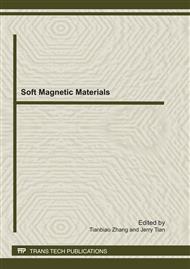p.20
p.23
p.29
p.35
p.40
p.45
p.51
p.56
p.63
A Novel Long-Life Air Working Electro-Active Actuator Based on Cellulose and Polyurethane Blend
Abstract:
In this paper, electro-active actuator made with cellulose and polyurethane blend film is prepared, which can show high bending displacement in the air with room humidity condition. To fabricate this actuator, cotton cellulose was dissolved into a N,N-dimethylacetamide (DMAc) and lithium chloride (LiCl) solvent system. Polyurethane prepared by poly[di(ethylene glycol) adipate] and hexamethylene diisocyanate (HDI) was mixed with DMAc cellulose solution by stirring. The mixed solution was cast to form a film followed by depositing thin gold electrode on both sides of the film. The actuator was actuated under AC voltage at an ambient condition by changing the actuation voltage, frequency and time. The actuator revealed a large bending displacement under low activation voltage, low electrical power consumption and good durability at room condition. This cellulose- polyurethane blend actuator is suitable for dry and durable actuator and promising for many biomimetic applications in foreseeable future.
Info:
Periodical:
Pages:
40-44
Citation:
Online since:
July 2011
Authors:
Keywords:
Price:
Сopyright:
© 2011 Trans Tech Publications Ltd. All Rights Reserved
Share:
Citation:


